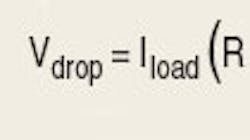Aerogel Capacitors Support Pulse, Hold-Up, and Main Power Applications
Where high currents are involved and conventional batteries are deficient, supercapacitors offer savings in size and a unique combination of high-power and high-energy performance parameters. Also referred to as ultracapacitors and electrochemical double layer capacitors (EDLC), supercapacitors fall between high-energy, low-power batteries and low-energy, high-power electrolytic capacitors. The PowerStor® aerogel capacitors (Fig. 1) are supercapacitors based on aerogel carbon as their active material — whereas the industry standard is activated carbon. It has a uniform pore size distribution, high usable surface area, and high electrical conductivity. Fig. 2, on page 60, shows the internal construction. For a given capacitance, it's between 2000 to 5000 times smaller than electrolytic capacitors. The following lists some features of this type of supercapacitor:
- Very low ESR for high power and low loss during operation.
- Ultra low leakage current (can hold a charge for several weeks).
- Wide operating temperature range.
- Can be cycled hundreds of thousands of times with very fast charge and discharge rates, as opposed to only hundreds of cycles for batteries.
Aerogel capacitors have characteristics making them ideal for applications in electronic circuits, battery-powered portable devices, and systems powered by fuel cell, batteries, or dc power supplies. You can use them in applications ranging from toys to microprocessor-controlled devices.
Aerogel capacitors provide:
- Hold-up power or bridge power to a device or equipment for seconds, minutes, or days when the main power or battery fails, or when the battery is swapped out.
- Pulse power characterized by short, high current pulses delivered to a load, allowing use of a smaller power supply or battery.
- Main power/battery replacement.
Pulse Power
These capacitors enable new pulse power applications. Often, standard batteries have insufficient power to actuate valves or solenoids, transmit wireless data, or start motors. In these situations, you previously had to use a larger battery or power supply. Paralleling a low-impedance, high-power aerogel capacitor and a high-impedance, high-energy battery, provides a low-impedance, high-power and high-energy power pack. Known as a hybrid battery-supercapacitor, it can provide high pulse power. Between pulses, the battery or power supply charges the aerogel capacitor at a rate determined by the battery or supply impedance. Major pulse applications involve valve and solenoid action, communications, computing, and hybrid electric vehicles.
Aerogel capacitors have a reasonably high energy density compared with rechargeable batteries. Some applications use batteries with more energy than required, take too long to charge, are shallow discharged (NiCd memory effect) on a continuous basis without periodic maintenance, or don't cycle long enough. In applications such as electronic toys, UPS systems, or solar charged lighting, aerogel capacitors have replaced batteries as a better alternative.
These aerogel capacitors include 2.5V ultra-low ESR and high capacitance radial leaded cylindrical, and 5V leaded rectangular devices. Also, there's a low-profile, flat-pack design with thickness ranging from 4 mm to as low as 1 mm.
Calculations
Pulse power applications are characterized by a relatively low value of continuous current with brief, high-current requirements. Applications have pulses ranging from <1 ms to as high as a few seconds. The duty cycle of the pulses is usually low, typically less than 20%.
A worst-case design analysis assumes the aerogel capacitor is the sole supplier of voltage during the pulse. Here the total drop in working voltage in the circuit consists of the instantaneous voltage drop due to load current supplied through the internal resistance of the capacitor, and the drop in capacitor voltage at the end of the pulse period. This relationship is:
R=Internal resistance (Ohms)
C=Capacitance (Farads)
Iload=Load current (A)
Vdrop=Change in voltage (V)
t=Time (sec)
For a small voltage drop, this equation shows the capacitor needs low R and high C. For many pulse power applications, the value of R is more important than C's value. For example, an aerogel capacitor has an estimated internal resistance of 0.060Ω and its specified capacitance is 1.5 F. For a 0.001 sec pulse, t/C is less than 0.001Ω. Even for a 0.010 sec pulse, it's only 0.007Ω. The value of R dominates the outcome of Vdrop in Equation (1).
When a working voltage of the circuit exceeds the maximum operating voltage rating of the aerogel capacitor, equal value capacitors can be put in series. Often, the series arrangement requires balancing to ensure equal voltage sharing. You can use passive or active balancing to maintain similar voltages among capacitors where the leakage currents may be different.
Passive balancing uses equal value resistors in parallel with the capacitors. Using high-value resistors, small currents may flow between the capacitors to maintain similar voltages. Resistors with high values result in lower leakage currents on the order of microamperes, an important design consideration for hybrid battery-supercapacitor solutions. Lower value resistors lead to higher leakage currents but faster voltage equilibration of mismatched components, and can be used where a continuous source of power delivers the main power.
Active balancing uses a microprocessor to measure voltage differences and open gates allowing equilibration to occur quickly — but only when needed. Active balancing doesn't add significant leakage in the final configuration, but comes at a higher price than passive balancing.
For more information on this article, CIRCLE 335 on Reader Service Card
